Internally Catalyzed Hydrogen Atom Transfer (I-CHAT)—A New Class of Reactions in Combustion Chemistry
Abstract
:1. Introduction
1.1. I-CHAT Mechanism
1.2. Low-T Chain Branching
2. Results and Discussion
2.1. Keto–Enol Tautomerization and Skeletal Double Bond Shift Isomerization
 | ||||||||||
| =A | χA (a) | XH | q (A) (b) | q (X) (b) | ΔG#I-CHAT | ν1 (c), cm−1 | ΔG#dir | ΔGr | q (H) (b) | q (C) (b) |
| S | 2.58 | OOH | −0.287 | −0.332 | 34.25 | −1162.2 | 55.97 | −1.95 | 0.261 | −0.333 |
| NH | 3.04 | OOH | −0.673 | −0.488 | 37.57 | −1083.8 | 65.97 | −0.14 | 0.358 | −0.043 |
| NH | 3.04 | SH | −0.757 | −0.302 | 38.30 | −1151.5 | 65.87 | −2.14 | 0.173 | −0.137 |
| O | 3.44 | OOH | −0.728 | −0.457 | 39.61 | −1481.4 | 68.10 | 6.07 | 0.356 | −0.06 |
| O | 3.44 | CH2OH | −0.755 | −0.657 | 40.17 | −1397.0 | 69.17 | 5.56 | 0.276 | −0.345 |
| O | 3.44 | COOH | −0.701 | −0.544 | 45.41 | −1456.1 | 70.73 | 7.83 | 0.375 | −0.354 |
| O | 3.44 | SH | −0.702 | −0.298 | 49.06 | −1295.9 | 70.75 | 6.17 | 0.200 | −0.239 |
| CH2 | 2.55 | OOH | −0.714 | −0.451 | 59.35 | −1681.2 | 75.75 | −1.08 | 0.330 | −0.025 |
- (1).
- Formally, an I-CHAT group consists of two reactive (double-centered) bonds such as O-O-H or CH2-O-O, involved in the TS to provide steric flexibility and orbital overlaps, except when a single bond is significantly longer to provide access to the acceptor site, as occurs in the case of the S–H bond. For instance, the hydroxymethyl (CH2OH) group as an I-CHAT-agent is sterically and energetically almost as effective as OOH (energy profiles are similar, and the barrier heights are very close: 39.61 vs. 40.17 kcal/mol, respectively), suggesting that the ring-strain indeed is the dominant factor in I-CHAT processes.
- (2).
- The decrease in ring strain in the I-CHAT TS, relative to the TS for the direct isomerization, is primarily due to the splitting of a small TS-ring of the uncatalyzed (direct) reaction into two larger rings of the catalyzed reaction, as shown in Scheme 2. In addition, one intramolecular H-bond between a pair of donor and acceptor centers (XH…A) is converted into two H-bonded donor-acceptor motifs (AH…X and XH…A, Scheme 3). Therefore, the barrier height dependence on the electronic characteristics is not straightforward; rather, it varies with the nature of the different constituent rings. The electronic structure (judging from partial atomic charges or relative electronegativities) of the two H-acceptor and donating centers (χA and χX) is, a priori, expected to play an important role, and their competition can be a key factor. Therefore, analyzing these factors can be useful in understanding the specific interactions during relay H-atom transfer.
- (3).
- Notably, the migrating H atom is more positively charged in enols than in the keto ground state, revealing the polar character of the H–OO bond as opposed to the C-H bond, which is more difficult to split. Thus, the more influential ring is the one involving the fission of the stronger C–H bond depending on the ability of the X-center to abstract the corresponding H-atom.
- (4).
- When a sterically more flexible and polar group (OOH) is combined with a longer double bond of the acceptor site such as C=S, the barrier is reduced. This is in accordance with conclusions from Francisco and coworkers on intermolecular H-migration processes, where longer S=O bond forms stronger H-bonds [89].
- (5).
- The barrier heights correlate with the topological properties of PESs. Particularly, an increase in the imaginary frequency in the TS correlates with the barrier heights among systems possessing the same XH catalyst group, e.g., OOH and SH in Table 1.
- (6).
2.2. Long-Range and Sequential I-CHAT Catalysis
2.3. An Outlook and Possible Implications of the I-CHAT Mechanism
2.4. Kinetic Analysis of an I-CHAT Process Employed for Model Generation
2.5. Chemical Kinetic Model Generation Using RMG and Simulation of IDT
3. Methodological Details
4. Summary and Conclusions
Supplementary Materials
Author Contributions
Funding
Institutional Review Board Statement
Informed Consent Statement
Data Availability Statement
Acknowledgments
Conflicts of Interest
References
- Walker, R.W.; Morley, C. Comprehensive Chemical Kinetics; Pilling, M.J., Ed.; Elsevier: Amsterdam, The Netherlands, 1997; Volume 35, pp. 1–124, Chapter 1. [Google Scholar] [CrossRef]
- Westbrook, C.K.; Mehl, M.; Pitz, W.J.; Kukkadapu, G.; Wagnon, S.; Zhang, K. Multi-fuel surrogate chemical kinetic mechanisms for real world applications. Phys. Chem. Chem. Phys. 2018, 20, 10588. [Google Scholar] [CrossRef] [PubMed]
- Zádor, J.; Taatjes, C.A.; Fernandes, R.X. Kinetics of elementary reactions in low-temperature autoignition chemistry. Prog. Energy Combust. Sci. 2011, 37, 371–421. [Google Scholar] [CrossRef]
- Simmie, J.M. Detailed chemical kinetic models for the combustion of hydrocarbon fuels. Prog. Energy Combust. Sci. 2003, 29, 599–634. [Google Scholar] [CrossRef]
- Wang, Z.; Herbinet, O.; Battin-Leclerc, F.; Hansen, N. Exploring hydroperoxides in combustion: History, recent advances and perspectives. Prog. Energy Combust. Sci. 2019, 73, 132–181. [Google Scholar] [CrossRef]
- Curran, H.J.; Gaffuri, P.; Pitz, W.J.; Westbrook, C.K. A Comprehensive Modeling Study of Iso-Octane Oxidation. Combust. Flame 2002, 129, 253–280. [Google Scholar] [CrossRef]
- Pilling, M.J. From Elementary Reactions to Evaluated Chemical Mechanisms for Combustion Models. Proc. Combust. Inst. 2009, 32, 27–44. [Google Scholar] [CrossRef]
- Asatryan, R.; Hudzik, J.; Swihart, M. Intramolecular Catalytic Hydrogen Atom Transfer (CHAT). J. Phys. Chem. A 2024, 128, 2169–2190. [Google Scholar] [CrossRef]
- Sahetchian, K.A.; Rigny, R.; Circan, S. Identification of the hydroperoxides formed by isomerization reactions during the oxidation of n-heptane in a reactor and CFR engine. Combust. Flame 1991, 85, 511–514. [Google Scholar] [CrossRef]
- Klippenstein, S.J. From theoretical reaction dynamics to chemical modeling of combustion. Proc. Comb. Inst. 2017, 36, 77–111. [Google Scholar] [CrossRef]
- Asatryan, R.; Bozzelli, J.W. Chain Branching and Termination in the Low-temperature Combustion of n-Alkanes: 2-Pentyl Radical + O2, Isomerization and Association of the Second O2. J. Phys. Chem. A 2010, 114, 7693–7708. [Google Scholar] [CrossRef]
- Goldsmith, C.F.; Green, W.H.; Klippenstein, S.J. Role of O2 + QOOH in low-temperature ignition of propane. 1. Temperature and pressure dependent rate coefficients. J. Phys. Chem. A 2012, 116, 3325–3346. [Google Scholar] [CrossRef]
- Liu, B.; Di, Q.; Lailliau, M.; Belhadj, N.; Dagaut, P.; Wang, Z. Experimental and kinetic modeling study of low-temperature oxidation of n-pentane. Combust. Flame 2023, 254, 112813. [Google Scholar] [CrossRef]
- Sahetchian, K.; Heiss, A.; Rigny, R.; Ben-Aïm, R. Determination of the gas-phase decomposition rate constants of heptyl-1 and heptyl-2 hydroperoxides C7H15OOH. Int. J. Chem. Kinet. 1982, 14, 1325–1337. [Google Scholar] [CrossRef]
- Asatryan, R.; Amiri, V.; Hudzik, J.; Swihart, M. Intramolecular Catalytic Hydrogen Atom Transfer (CHAT): A Novel Mechanism Relevant to the Combustion of Traditional Fuels. In Proceedings of the AIChE Annual Meeting, Orlando, FL, USA, 5–10 November 2023. [Google Scholar]
- Westbrook, C.K. Chemical kinetics of hydrocarbon ignition in practical combustion systems. Proc. Combust. Inst. 2000, 28, 1563–1577. [Google Scholar] [CrossRef]
- Wang, Z.; Popolan-Vaida, D.M.; Chen, B.; Moshammer, K.; Mohamed, S.Y.; Wang, H.; Sioud, S.; Raji, M.A.; Kohse-Hoinghaus, K.; Hansen, N.; et al. Unraveling the structure and chemical mechanisms of highly oxygenated intermediates in oxidation of organic compounds. Proc. Natl. Acad. Sci. USA 2017, 114, 13102–13107. [Google Scholar] [CrossRef]
- Belhadj, N.; Benoit, R.; Dagaut, P.; Lailliau, M. Experimental characterization of n-heptane low-temperature oxidation products including keto-hydroperoxides and highly oxygenated organic molecules (HOMs). Combust. Flame 2021, 224, 83–93. [Google Scholar] [CrossRef]
- Belhadj, N.; Lailliau, M.; Benoit, R.; Dagaut, P. Experimental and kinetic modeling study of n-pentane oxidation at 10 atm, Detection of complex low-temperature products by Q-Exactive Orbitrap. Combust. Flame 2022, 235, 111723. [Google Scholar] [CrossRef]
- Wang, Z.; Zhang, L.; Moshammer, K.; Popolan-Vaida, D.M.; Shankar, V.S.B.; Lucassen, A.; Hemken, C.; Taatjes, C.A.; Leone, S.R.; Kohse-Höinghaus, K.; et al. Additional chain-branching pathways in the low-temperature oxidation of branched alkanes. Combust. Flame 2016, 164, 386–396. [Google Scholar] [CrossRef]
- Amiri, V.; Asatryan, R.; Swihart, M. Automated Generation of a Compact Chemical Kinetic Model for n-Pentane Combustion. ACS Omega 2023, 8, 49098–49114. [Google Scholar] [CrossRef]
- Cox, R.A.; Cole, J.A. Chemical aspects of the autoignition of hydrocarbon-air mixtures. Combust. Flame 1985, 60, 109–123. [Google Scholar] [CrossRef]
- Jens, E.T.; Cantwell, B.J.; Hubard, G.S. Hybrid Rocket Propulsion for outer planet exploration. Acta Astronaut. 2016, 128, 119–130. [Google Scholar] [CrossRef]
- Petrarolo, A.; Kobald, M.; Schlechtriem, S. Optical analysis of the liquid layer combustion of paraffin-based hybrid rocket fuels. Acta Astronaut. 2019, 158, 313–322. [Google Scholar] [CrossRef]
- Leccese, G.; Cavallini, E.; Pizzarelli, M. State of Art and Current Challenges of the Paraffin-Based Hybrid Rocket Technology. In AIAA Propulsion and Energy Forum; American Institute of Aeronautics and Astronautics: Reston, VA, USA, 2019. [Google Scholar]
- Amiri, V.; Hudzik, J.; Asatryan, R.; Wagnon, S.W.; Swihart, M. Chemical Kinetic Mechanism for Extra-Large n-Alkanes (C > 20). Energy Fuels, 2025; to be submitted. [Google Scholar]
- Jalan, A.; Alecu, I.M.; Meana-Pañeda, R.; Aguilera-Iparraguirre, J.; Yang, K.R.; Merchant, S.S.; Truhlar, D.G.; Green, W.H. New Pathways for Formation of Acids and Carbonyl Products in Low-Temperature Oxidation: The Korcek Decomposition of γ-Ketohydroperoxides. J. Am. Chem. Soc. 2013, 135, 11100–11114. [Google Scholar] [CrossRef]
- Asatryan, R.; Ruckenstein, E. Dihydrogen Catalysis: A Remarkable Avenue in the Reactivity of Molecular Hydrogen. Catal. Rev. 2014, 56, 403–475. [Google Scholar] [CrossRef]
- Asatryan, R.; Bozzelli, J.W.; Ruckenstein, E. Dihydrogen Catalysis: A Degradation Mechanism for N2-Fixation Intermediates. J. Phys. Chem. A 2012, 116, 11618–11642. [Google Scholar] [CrossRef]
- IUPAC. Compendium of Chemical Terminology, 2nd ed.; Blackwell Scientific Publications: Oxford, UK, 1997; ISBN 0-9678550-9-8. [Google Scholar] [CrossRef]
- Fersht, A.R.; Kirby, A.J. Intramolecular Nucleophilic Catalysis of Ester Hydrolysis by the Ionized Carboxyl Group. The Hydrolysis of 3,5-Dinitroaspirin Anion. J. Am. Chem. Soc. 1968, 90, 5818–5826. [Google Scholar] [CrossRef]
- Cox, C.; Young Jr, V.G.; Lectka, T. Intramolecular Catalysis of Amide Isomerization. J. Am. Chem. Soc. 1997, 119, 2307–2308. [Google Scholar] [CrossRef]
- Kumar, M.; Sinha, A.; Francisco, J.S. Role of double hydrogen atom transfer reactions in atmospheric chemistry. Acc. Chem. Res. 2016, 49, 877e883. [Google Scholar] [CrossRef]
- Kohl, I.E.; Asatryan, R.; Bao, H. No oxygen isotope exchange between water and APS-sulfate at surface temperature: Evidence from quantum chemical modeling and triple-oxygen isotope experiments. Geochim. Cosmochim. Acta 2012, 95, 106–118. [Google Scholar] [CrossRef]
- Kasha, M. Proton-transfer Spectroscopy. Perturbation of the Tautomerization Potential. J. Chem. Soc. Faraday Trans. 2 1986, 82, 2379–2392. [Google Scholar] [CrossRef]
- Wu, C.-C.; Lien, M.-H. Ab initio study on the substituent effect in the transition state of keto-enol tautomerism of acetyl derivatives. J. Phys. Chem. 1996, 100, 594–600. [Google Scholar] [CrossRef]
- Bernasconi, C.F.; Fairchild, D.E.; Murray, C.J. Kinetic solvent isotope effect and proton inventory study of the carbon protonation of amine adducts of benzylidene Meldrum’s acid and other Meldrum’s acid derivatives. Evidence for concerted intramolecular proton transfer. J. Am. Chem. Soc. 1987, 109, 3409–3415. [Google Scholar] [CrossRef]
- Song, P.-S.; Sun, M.; Koziolawa, A.; Koziol, J. Phototautomerism of lumichromes and alloxazines. J. Am. Chem. Soc. 1974, 96, 4319–4323. [Google Scholar] [CrossRef]
- Asatryan, R.; da Silva, G.; Bozzelli, J.W. Quantum chemical study of the acrolein (CH2CHCHO) + OH + O reactions. J. Phys. Chem. A 2010, 114, 8302–8311. [Google Scholar] [CrossRef]
- Burke, M.P.; Goldsmith, C.F.; Georgievskii, Y.; Klippenstein, S.J. Towards a quantitative understanding of the role of non-Boltzmann reactant distributions in low temperature oxidation. Proc. Combust. Inst. 2015, 35, 205–213. [Google Scholar] [CrossRef]
- Goldsmith, C.F.; PBurke, M.; Georgievskii, Y.; Klippenstein, S.J. Effect of non-thermal product energy distributions on ketohydroperoxide decomposition kinetics. Proc. Combust. Inst. 2015, 35, 283–290. [Google Scholar] [CrossRef]
- DeSain, J.D.; Taatjes, C.A.; Miller, J.A.; Klippenstein, S.J.; Hahn, D.K. Infrared frequency-modulation probing of product formation in alkyl + O2 reactions. Part IV. Reactions of propyl and butyl radicals with O2. Faraday Discuss. 2002, 119, 101. [Google Scholar] [CrossRef]
- Sahetchian, K.A.; Rigny, R.; Tardieu de Maleissye, J.; Batt, L.; Anwar Khan, M.; Mathews, S. The pyrolysis of organic hydroperoxides (ROOH). Proc. Combust. Inst. 1992, 24, 637–643. [Google Scholar] [CrossRef]
- Knyazev, V.D.; Slagle, I.R. Thermochemistry of the R-O2 Bond in Alkyl and Chloroalkyl Peroxy Radicals. J. Phys. Chem. A 1998, 102, 1770–1778. [Google Scholar] [CrossRef]
- Mantashyan, A.A.; Khachatryan, L.A.; Niazyan, O.M.; Arsentyev, S.D. On the reactions of peroxy radicals in the slow combustion of methane and ethylene. Combust. Flame 1981, 43, 221–227. [Google Scholar] [CrossRef]
- Knox, J.H.; Kinnear, C.G. The mechanism of combustion of pentane in the gas phase between 250 °C and 400 °C. Symp. Int. Combust. 1971, 13, 217–227. [Google Scholar] [CrossRef]
- Fernandes, R.X.; Zádor, J.; Jusinski, L.E.; Miller, J.A.; Taatjes, C.A. Formally direct pathways and low-temperature chain branching in hydrocarbon autoignition: The cyclohexyl + O2 reaction at high pressure. Phys. Chem. Chem. Phys. 2009, 11, 1320–1327. [Google Scholar] [CrossRef]
- Asatryan, R.; Bozzelli, J.W. Chain branching and termination paths in oxidation of n-alkanes: Comprehensive Complete Basis Set-QB3 study on the association of n-pentyl radical with O2, isomerization and addition of second oxygen molecule. In Proceedings of the Eastern States Section Combust Institute Meeting, Charlottesville, VA, USA, 21–24 October 2007. [Google Scholar]
- Asatryan, R.; Bozzelli, J.W. Chain Branching and Termination in Low Temperature Combustion of n-Alkanes: n-Pentan-2-yl Radical Plus O2, Isomerization and Addition of Second O2. In Proceedings of the 32nd International Symposia Combustion, Montreal, QU, Canada, 3–8 August 2008. [Google Scholar]
- Sharma, S.; Raman, S.; Green, W.H. Intramolecular Hydrogen Migration in Alkylperoxy and Hydroperoxyalkylperoxy Radicals: Accurate Treatment of Hindered Rotors. J. Phys. Chem. A 2010, 114, 5689–5701. [Google Scholar] [CrossRef] [PubMed]
- Miyoshi, A. Systematic computational study on the unimolecular reactions of alkylperoxy (RO2), hydroperoxyalkyl (QOOH), and hydroperoxyalkylperoxy (O2QOOH) radicals. J. Phys. Chem. A 2011, 115, 3301–3325. [Google Scholar] [CrossRef]
- Xing, L.; Bao, J.; Wang, Z.; Wang, X.; Truhlar, D.G. Hydrogen shift isomerizations in the kinetics of the second oxidation mechanism of alkane combustion. Reactions of the hydroperoxypentylperoxy OOQOOH radical. Combust. Flame 2018, 197, 88–101. [Google Scholar] [CrossRef]
- Davis, M.M.; Weidman, J.D.; Abbott, A.S.; Douberly, G.E.; Turney, J.M.; Schaefer, H.F., III. Characterization of the 2-methylvinoxy radical + O2 reaction: A focal point analysis and composite multireference study. J. Chem. Phys. 2019, 151, 124302. [Google Scholar] [CrossRef]
- Sahetchian, K.; Champoussin, J.C.; Brun, M.; Levy, N.; Blin-Simiand, N.; Aligrot, C.; Jorand, F.; Socoliuc, M.; Heiss, A.; Guerassi, N. Experimental study and modeling of dodecane ignition in a diesel engine. Combust. Flame 1995, 103, 207–220. [Google Scholar] [CrossRef]
- Blin-Simiand, N.; Rigny, R.; Viossat, V.; Circan, S.; Sahetchian, K. Autoignition of hydrocarbon/Air Mixtures in a CFR Engine: Experimental and Modeling Study. Combust. Sci. Tech. 1993, 88, 329–348. [Google Scholar] [CrossRef]
- Xing, L.; Bao, J.L.; Wang, Z.; Zhang, F.; Truhlar, D.G. Degradation of carbonyl hydroperoxides in the atmosphere and in combustion. J. Am. Chem. Soc. 2017, 139, 15821–15835. [Google Scholar] [CrossRef]
- Blin-Simiand, N.; Jorand, F.; Keller, K.; Fiderer, M.; Sahetchian, K. Ketohydroperoxides and ignition delay in internal combustion engines. Combust. Flame 1998, 112, 278–282. [Google Scholar] [CrossRef]
- Hansen, A.S.; Bhagde, T.; Qian, Y.; Cavazos, A.; Huchmala, R.M.; Boyer, M.A.; Gavin-Hanner, C.F.; Klippenstein, S.J.; McCoy, A.B.; Lester, M.I. Infrared spectroscopic signature of a hydroperoxyalkyl radical (●QOOH). J. Chem. Phys. 2022, 156, 014301. [Google Scholar] [CrossRef]
- Jorand, F.; Hess, A.; Perrin, O.; Sahetchian, K.; Kerhoas, L.; Einhorn, J. Isomeric hexyl-ketohydroperoxides formed by reactions of hexoxy and hexylperoxy radicals in oxygen. Int. J. Chem. Kinet. 2003, 35, 354–366. [Google Scholar] [CrossRef]
- Sahetchian, K.A.; Blin, N.; Rigny, R.; Seydi, A.; Murat, M. The oxidation of n-butane and n-heptane in a CFR engine. Isomerization reactions and delay of autoignition. Combust. Flame 1990, 79, 242–249. [Google Scholar] [CrossRef]
- Blin-Simiand, N.; Jorand, F.; Sahetchian, K.; Brun, M.; Kerhoas, L.; Malosse, C.; Ein-horn, J. Hydroperoxides with zero, one, two or more carbonyl groups formed during the oxidation of n-dodecane. Combust. Flame 2001, 126, 1524–1532. [Google Scholar] [CrossRef]
- Eskola, A.J.; Zador Jt Antonov, I.O.; Sheps, L.; Savee, J.D.; Osborn, D.L.; Taatjes, C.A. Probing the Low-Temperature Chain-Branching Mechanism for n-Butane Autoignition Chemistry via Time-Resolved Measurements of Ketohydroperoxide Formation in Photolytically Initiated n-C4H10 Oxidation. Proc. Combust. Inst. 2015, 35, 291–298. [Google Scholar] [CrossRef]
- Eskola, A.J.; Antonov, I.O.; Sheps, L.; Savee, J.D.; Osborn, D.L.; Taatjes, C.A. Time-resolved measurements of product formation in the low-temperature (550–675 K) oxidation of neopentane: A probe to investigate chain-branching mechanism. Phys. Chem. Chem. Phys. 2017, 19, 13731–13745. [Google Scholar] [CrossRef]
- Battin-Leclerc, F.; Herbinet, O.; Glaude, P.-A.; Fournet, R.; Zhou, Z.; Deng, L.; Guo, H.; Xie, M.; Qi, F. New experimental evidences about the formation and consumption of ketohydroperoxides. Proc. Combust. Inst. 2011, 33, 325–331. [Google Scholar] [CrossRef]
- Rodriguez, A.; Herbinet, O.; Wang, Z.; Qi, F.; Fittschen, C.; Westmoreland, P.R.; Battin-Leclerc, F. Measuring hydroperoxide chain-branching agents during n-pentane low-temperature oxidation. Proc. Combust. Inst. 2017, 36, 333–342. [Google Scholar] [CrossRef]
- Bourgalais, J.; Gouid, Z.; Herbinet, O.; Garcia, G.A.; Arnoux, P.; Wang, Z.; Tran, L.-S.; Vanhove, G.; Hochlaf, M.; Nahon, L.; et al. Isomer-sensitive characterization of low temperature oxidation reaction products by coupling a jet-stirred reactor to an electron/ion coincidence spectrometer: Case of n-pentane. Phys. Chem. Chem. Phys. 2020, 22, 1222–1241. [Google Scholar] [CrossRef]
- Pelucchi, M.; Bissoli, M.; Cavallotti, C.; Cuoci, A.; Faravelli, T.; Frassoldati, A.; Ranzi, E.; Stagni, A. Improved Kinetic Model of the Low-Temperature Oxidation of n-Heptane. Energy Fuels 2014, 28, 7178–7193. [Google Scholar] [CrossRef]
- Ranzi, E.; Cavallotti, C.; Cuoci, A.; Frassoldati, A.; Pelucchi, M.; Faravelli, T. New reaction classes in the kinetic modeling of low temperature oxidation of n-alkanes. Combust. Flame 2015, 162, 1679–1691. [Google Scholar] [CrossRef]
- Hansen, N.; Moshammer, K.; Jasper, A.W. Isomer-Selective Detection of Keto-Hydroperoxides in the Low-Temperature Oxidation of Tetrahydrofuran. J. Phys. Chem. A 2019, 123, 8274–8284. [Google Scholar] [CrossRef] [PubMed]
- Moshammer, K.; Jasper, A.W.; Popolan-Vaida, D.M.; Lucassen, A.; Diévart, P.; Selim, H.; Eskola, A.J.; Taatjes, C.A.; Leone, S.R.; Sarathy, S.M.; et al. Detection and Identification of the Keto-Hydroperoxide (HOOCH2OCHO) and Other Intermediates during Low-Temperature Oxidation of Dimethyl Ether. J. Phys. Chem. A 2015, 119, 7361–7374. [Google Scholar] [CrossRef]
- Moshammer, K.; Jasper, A.W.; Popolan-Vaida, D.M.; Wang, Z.D.; Shankar VS, B.; Ruwe, L.; Taatjes, C.A.; Dagaut, P.; Hansen, N. Quantification of the Keto-Hydroperoxide (HOOCH2OCHO) and Other Elusive Intermediates during Low-Temperature Oxidation of Dimethyl Ether. J. Phys. Chem. A 2016, 120, 7890–7901. [Google Scholar] [CrossRef]
- Mutzel, A.; Poulain, L.; Berndt, T.; Iinuma, Y.; Rodigast, M.; Böge, O.; Richters, S.; Spindler, G.; Sipilä, M.; Jokinen, T.; et al. Highly Oxidized Multifunctional Organic Compounds Observed in Tropospheric Particles: A Field and Laboratory Study. Environ. Sci. Technol. 2015, 49, 7754–7761. [Google Scholar] [CrossRef]
- Battin-Leclerc, F.; Rodriguez, A.; Husson, B.; Herbinet, O.; Glaude, P.A.; Wang, Z.; Cheng, Z.; Qi, F. Products from the oxidation of linear isomers of hexene. J. Phys. Chem. A 2014, 118, 673–683. [Google Scholar] [CrossRef]
- Farouk, T.I.; Xu, Y.; Avedisian, C.T.; Dryer, F.L. Combustion characteristics of primary reference fuel (PRF) droplets: Single stage high temperature combustion to multistage “Cool Flame” behavior. Proc. Combust. Inst. 2017, 36, 2585–2594. [Google Scholar] [CrossRef]
- Popolan-Vaida, D.M.; Eskola, A.J.; Rotavera, B.; Lockyear, J.F.; Wang, Z.; Sarathy, S.M.; Caravan, R.L.; Zador, J.; Sheps, L.; Lucassen, A.; et al. Formation of Organic Acids and Carbonyl Compounds in n-Butane Oxidation via γ-Ketohydroperoxide Decomposition. Angew. Chem. Int. Ed. 2022, 61, e202209168. [Google Scholar] [CrossRef]
- Taatjes, C.A.; Hansen, N.; McIlroy, A.; Miller, J.A.; Senosiain, J.P.; Klippenstein, S.J.; Qi, F.; Sheng, L.; Zhang, Y.; Cool, T.A.; et al. Enols Are Common Intermediates in Hydrocarbon Oxidation. Science 2005, 308, 1887–1889. [Google Scholar] [CrossRef]
- Taatjes, C.A.; Hansen, N.; Miller, J.A.; Cool, T.A.; Wang, J.; Westmoreland, P.R.; Law, M.E.; Kasper, T.; Kohse-Höinghaus, K. Combustion Chemistry of Enols: Possible Ethenol Precursors in Flames. J. Phys. Chem. A 2006, 110, 3254. [Google Scholar] [CrossRef]
- Huynh, L.K.; Zhang, H.R.; Zhang, S.; Eddings, E.; Sarofim, A.; Law, M.E.; Westmoreland, P.R.; Truong, T.N. Kinetics of Enol Formation from Reaction of OH with Propene. J. Phys. Chem. A 2009, 113, 3177–3185. [Google Scholar] [CrossRef] [PubMed]
- Archibald, A.T.; McGillen, M.R.; Taatjes, C.A.; Percival, C.J.; Shallcross, D.E. Atmospheric transformation of enols: A potential secondary source of carboxylic acids in the urban troposphere. Geophys. Res. Lett. 2007, 34, L21801. [Google Scholar] [CrossRef]
- Erfle, S.; Reim, S.; Michalik, D.; Jiao, H.; Langer, P. Experimental and Theoretical Study of the Keto–Enol Tautomerization of 3,5-Dioxopimelates. Eur. J. Org. Chem. 2011, 4367–4372. [Google Scholar] [CrossRef]
- Antonov, L. Tautomerism: Concepts and Applications in Science and Technology; Wiley-VCH: Weinheim, Germany, 2016. [Google Scholar]
- Perez, P.; Toro-Labbe, A. Characterization of Keto-Enol Tautomerism of Acetyl Derivatives from the Analysis of Energy, Chemical Potential, and Hardness. J. Phys. Chem. A 2000, 104, 1557–1562. [Google Scholar] [CrossRef]
- Couch, D.E.; Nguyen QL, D.; Liu, A.; Hickstein, D.D.; Kapteyn, H.C.; Murnane, M.M.; Labbe, N.J. Detection of the keto-enol tautomerization in acetaldehyde, acetone, cyclohexanone, and methyl vinyl ketone with a novel VUV light source. Proc. Comb. Inst. 2021, 368, 1737–1744. [Google Scholar] [CrossRef]
- Ali, S.T.; Antonov, L.; Fabian, W.M.F. Phenol–quinone tautomerism in (Arylazo)naphthols and the analogous Schiff bases: Benchmark calculations. J Phys. Chem. A 2014, 118, 778–789. [Google Scholar] [CrossRef]
- Jana, K.; Ganguly, B. DFT Study to Explore the Importance of Ring Size and Effect of Solvents on the Keto−Enol Tautomerization Process of α- and β-Cyclodiones. ACS Omega 2018, 3, 8429–8439. [Google Scholar] [CrossRef]
- Jana, K.; Ganguly, B. DFT studies on quantum mechanical tunneling in tautomerization of three-membered rings. Phys. Chem. Chem. Phys. 2018, 20, 28049. [Google Scholar] [CrossRef]
- Mehrani, S.; Tayyari, S.F.; Heravi, M.M.; Morsali, A. Theoretical investigation of solvent effect on the keto–enol tautomerization of pentane-2,4-dione and a comparison between experimental data and theoretical calculations. Can. J. Chem. 2021, 99, 411–424. [Google Scholar] [CrossRef]
- Roy, P.; Biswas, S.; Pramanik, A.; Sarkar, P. Computational Studies on the Keto-Enol Tautomerism of Acetylacetone. Int. J. Res. Soc. Nat. Sci. 2017, 2, 2455–5916. [Google Scholar]
- Kumar, M.; Francisco, J.S. Hydrogen Sulfide Induced Carbon Dioxide Activation by Metal-Free Dual Catalysis. Chem. Eur. J. 2016, 22, 4359–4363. [Google Scholar] [CrossRef]
- Evans, M.G.; Polanyi, M. Further Considerations on the Thermodynamics of Chemical Equilibria and Reaction Rates. Trans. Faraday Soc. 1936, 32, 1333–1360. [Google Scholar] [CrossRef]
- Bell, R.P. The Theory of Reactions Involving Proton Transfers. Proc. R. Soc. A 1936, 154, 414–429. [Google Scholar]
- Semenov, N.N. Some Problems in Chemical Kinetics and Reactivity; Princeton University Press: Princeton, NJ, USA, 1958; Volume 1, p. 254. [Google Scholar]
- Vereecken, L.; Francisco, J.S. Theoretical studies of atmospheric reaction mechanisms in the troposphere. Chem. Soc. Rev. 2012, 41, 6259–6293. [Google Scholar] [CrossRef] [PubMed]
- Tsukahara, T.; Nagaoka, K.; Morikawa, K.; Mawatari, K.; Kitamori, T. Keto-Enol Tautomeric Equilibrium of Acetylacetone Solution Confined in Extended Nanospaces. J. Phys. Chem. B 2015, 119, 14750–14755. [Google Scholar] [CrossRef]
- Alarcon, J.F.; Ajo, S.; Morozov, A.N.; Mebel, A.M. Theoretical study on the mechanism and kinetics of the oxidation of allyl radical with atomic and molecular oxygen. Combust. Flame 2023, 257, 112388. [Google Scholar] [CrossRef]
- Bahrini, C.; Herbinet, O.; Glaude, P.-A.; Schoemaecker, C.; Fittschen, C.; Battin-Leclerc, F. Quantification of hydrogen peroxide during the low-temperature oxidation of alkanes. J Am Chem Soc. 2012, 134, 11944–11947. [Google Scholar] [CrossRef]
- Bugler, J.; Rodriguez, A.; Herbinet, O.; Battin-Leclerc, F.; Togbe’, C.; Dayma, G.; Dagaut, P.; Curran, H.J. An experimental and modelling study of n-pentane oxidation in two jet-stirred reactors: The importance of pressure-dependent kinetics and new reaction pathways. Proc. Comb Inst. 2017, 36, 441–448. [Google Scholar] [CrossRef]
- Dana, A.G.; Johnson, M.S.; Allen, J.W.; Sharma, S.; Raman, S.; Liu, M.; Gao, C.W.; Grambow, C.A.; Goldman, M.J.; Ranasinghe, D.S.; et al. Automated reaction kinetics and network exploration (Arkane): A statistical mechanics, thermodynamics, transition state theory, and master equation software. Int. J. Chem. Kinet. 2023, 55, 300–323. [Google Scholar] [CrossRef]
- Gao, C.W.; Allen, J.W.; Green, W.H.; West, R.H. Reaction Mechanism Generator: Automatic construction of chemical kinetic mechanisms. Comput. Phys. Commun. 2016, 203, 212–225. [Google Scholar] [CrossRef]
- Liu, M.; Grinberg Dana, A.; Johnson, M.S.; Goldman, M.J.; Jocher, A.; Mark Payne, A.; Grambow, C.A.; Han, K.; Yee, N.W.; Mazeau, E.J.; et al. Reaction Mechanism Generator v3.0: Advances in Automatic Mechanism Generation. J. Chem. Inf. Model. 2021, 61, 2686–2696. [Google Scholar] [CrossRef] [PubMed]
- Johnson, M.S.; Dong, X.; Grinberg Dana, A.; Chung, Y.; Farina, D.; Gillis, R.J.; Liu, M.; Yee, N.W.; Blondal, K.; Mazeau, E.; et al. The RMG Database for Chemical Property Prediction. Chem. Inf. 2022, 62, 4906–4915. [Google Scholar] [CrossRef] [PubMed]
- Kee, R.J.; Rupley, F.M.; Miller, J.A. Chemkin-II: A Fortran Chemical Kinetics Package for the Analysis of Gas-Phase Chemical Kinetics; Sandia National Laboratories: Livermore, CA, USA, 1989. [Google Scholar]
- CHEMKIN-PRO 15112; Reaction Design: San Diego, CA, USA, 2023.
- Bugler, J.; Marks, B.; Mathieu, O.; Archuleta, R.; Camou, A.; Grégoire, C.; Heufer, K.A.; Petersen, E.L.; Curran, H.J. An ignition delay time and chemical kinetic modeling study of the pentane isomers. Combust. Flame 2016, 163, 138–156. [Google Scholar] [CrossRef]
- Johnson, M.S.; Green, W.H. A machine learning based approach to reaction rate estimation. React. Chem. Eng. 2024, 9, 1364–1380. [Google Scholar] [CrossRef]
- Asatryan, R.; Bozzelli, J.W.; Simmie, J.M. Thermochemistry of methyl and ethyl nitro, RNO2, and nitrite, RONO, organic compounds. J. Phys. Chem. A 2008, 112, 3172–3185. [Google Scholar] [CrossRef]
- Burke, M.P.; Chaos, M.; Ju, Y.; Dryer, F.L.; Klippenstein, S.J. Comprehensive H2/O2 kinetic model for high-pressure combustion. Int. J. Chem. Kinet. 2012, 44, 444–474. [Google Scholar] [CrossRef]
- Hashemi, H.; Jacobsen, J.G.; Rasmussen, C.T.; Christensen, J.M.; Glarborg, P.; Gersen, S.; van Essen, M.; Levinsky, H.B.; Klippenstein, S.J. High-pressure oxidation of ethane. Combust. Flame 2017, 182, 150–166. [Google Scholar] [CrossRef]
- Goldsmith, C.F.; Magoon, G.R.; Green, W.H. Database of Small Molecule Thermochemistry for Combustion. J. Phys. Chem. A 2012, 116, 9033–9057. [Google Scholar] [CrossRef]
- Zhao, Y.; Truhlar, D.G. The M06 suite of density functionals for main group thermochemistry, thermochemical kinetics, noncovalent interactions, excited states, and transition elements: Two new functionals and systematic testing of four M06-class functionals and 12 other functionals. Theor. Chem. Acc. 2008, 120, 215–241. [Google Scholar]
- Dunning, T.H., Jr. Gaussian Basis Sets for Use in Correlated Molecular Calculations. I. The Atoms Boron through Neon and Hydrogen. J. Chem. Phys. 1989, 90, 1007–1023. [Google Scholar] [CrossRef]
- Asatryan, R.; Pal, Y.; Hachmann, J.; Ruckenstein, E. Roaming-like Mechanism for Dehydration of Diol Radicals. J. Phys. Chem. A 2018, 122, 9738–9754. [Google Scholar] [CrossRef]
- Asatryan, R.; Hudzik, J.M.; Bozzelli, J.W.; Khachatryan, L.; Ruckenstein, E. OH-Initiated Reactions of p-Coumaryl Alcohol Relevant to the Lignin Pyrolysis. Part I. Potential Energy Surface Analysis. J. Phys. Chem. A 2019, 123, 2570–2585. [Google Scholar] [CrossRef] [PubMed]
- Pieniazek, S.N.; Clemente, F.R.; Houk, K.N. Sources of error in DFT computations of C–C bond formation thermochemistries: π→σ transformations and error cancellation by DFT methods. Angew. Chem. Int. Ed. Engl. 2008, 47, 7746–7749. [Google Scholar] [CrossRef] [PubMed]
- Hohenstein, E.G.; Chill, S.T.; Sherrill, C.D. Assessment of the performance of the M05-2X and M06-2X exchange-correlation functionals for noncovalent interactions in biomolecules. J. Chem. Theory Comput. 2008, 4, 1996–2000. [Google Scholar] [CrossRef] [PubMed]
- McCann, B.W.; McFarland, S.; Acevedo, O. Benchmark continuum solvent models for keto-enol tautomerizations. J. Phys. Chem. A 2015, 119, 8724–8733. [Google Scholar] [CrossRef]
- Zheng, J.; Xu, X.; Truhlar, D.G. Minimally augmented Karlsruhe basis sets. Theor. Chem. Acc. 2011, 128, 295–305. [Google Scholar] [CrossRef]
- Frisch, M.J.; Trucks, G.W.; Schlegel, H.B.; Scuseria, G.E.; Robb, M.A.; Cheeseman, J.R.; Scalmani, G.; Barone, V.; Petersson, G.A.; Nakatsuji, H.; et al. Gaussian 16, revision A.03; Gaussian, Inc.: Wallingford, CT, USA, 2016. [Google Scholar]
- Furrow, S.D.; Field, R.J.; Burger, M. Oscillations and Traveling Waves in Chemical Systems; Wiley & Sons: New York, NY, USA, 1985. [Google Scholar]
- Cleaves, H.J. Formose Reaction. In Encyclopedia of Astrobiology; Gargaud, M., Ed.; Springer: Berlin/Heidelberg, Germany, 2011. [Google Scholar] [CrossRef]
- Vansco, M.F.; Zuraski, K.; Winiberg, F.A.F.; Au, K.; Trongsiriwat, N.; Walsh, P.J.; Osborn, D.L.; Percival, C.J.; Klippenstein, S.J.; Taatjes, C.A.; et al. Functionalized hydroperoxide formation from the reaction of methacrolein-oxide, an isoprene-derived Criegee intermediate, with formic acid: Experiment and theory. Molecules 1921, 26, 3058. [Google Scholar] [CrossRef]
- Demerjian, K.L. The mechanism of photochemical smog formation. Adv. Environ. Sci. Technol. 1974, 4, 1–262. [Google Scholar]
- Kroll, J.H.; Donahue, N.M.; Cee, V.J.; Demerjian, K.L.; Anderson, J.G. Gas-Phase Ozonolysis of Alkenes: Formation of OH from Anti Carbonyl Oxides. J. Am. Chem. Soc. 2002, 124, 8518–8519. [Google Scholar] [CrossRef]
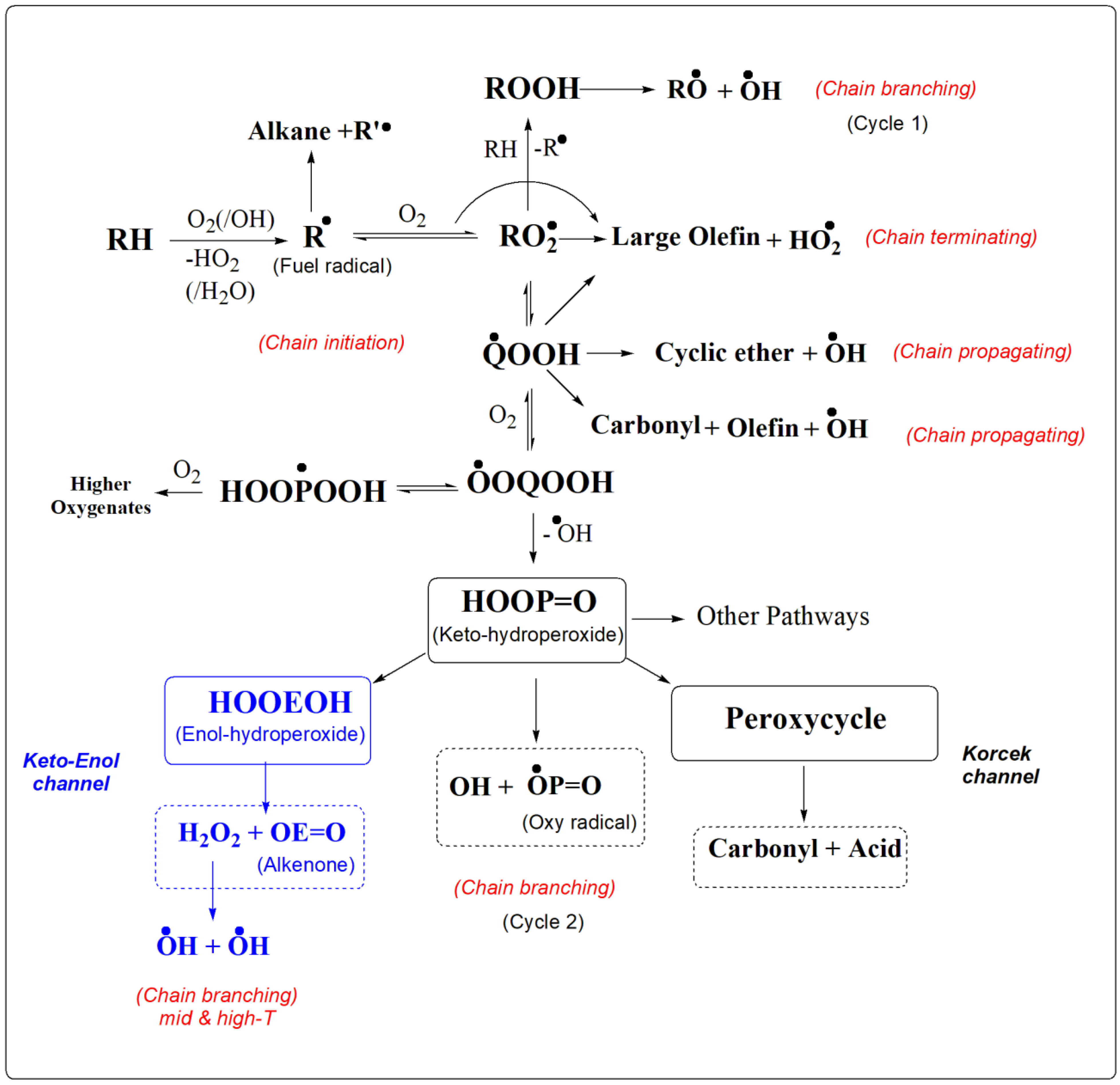
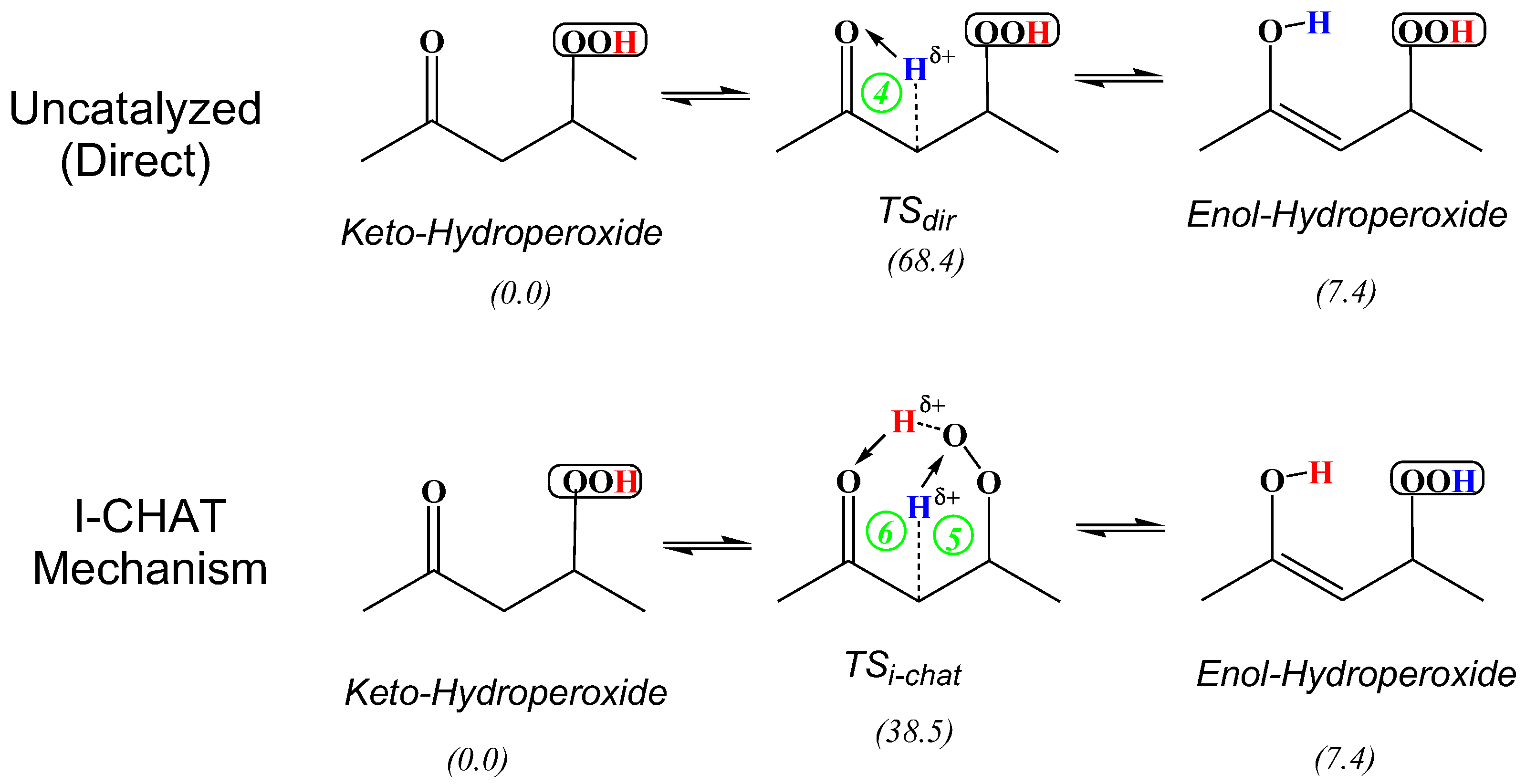

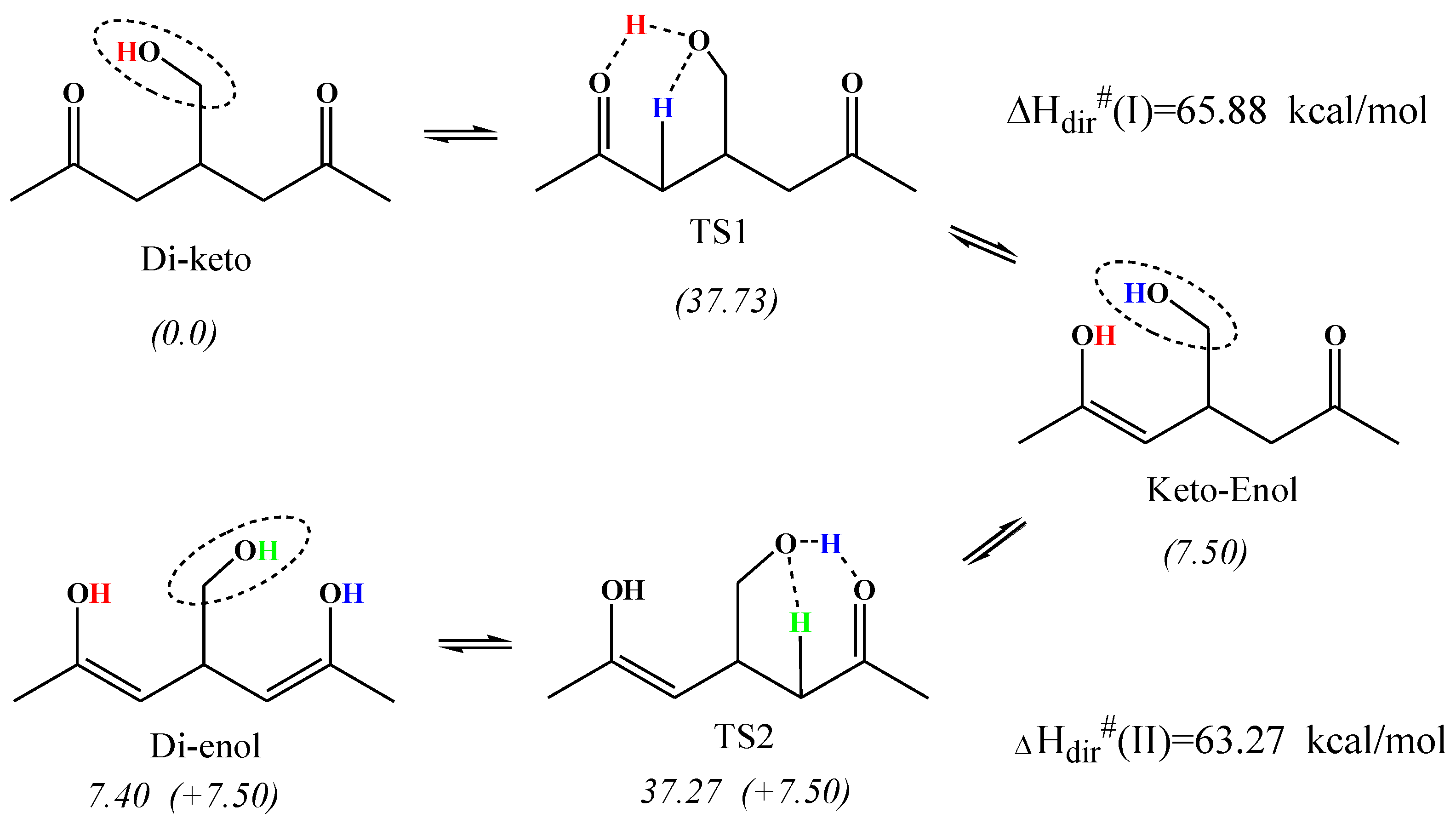
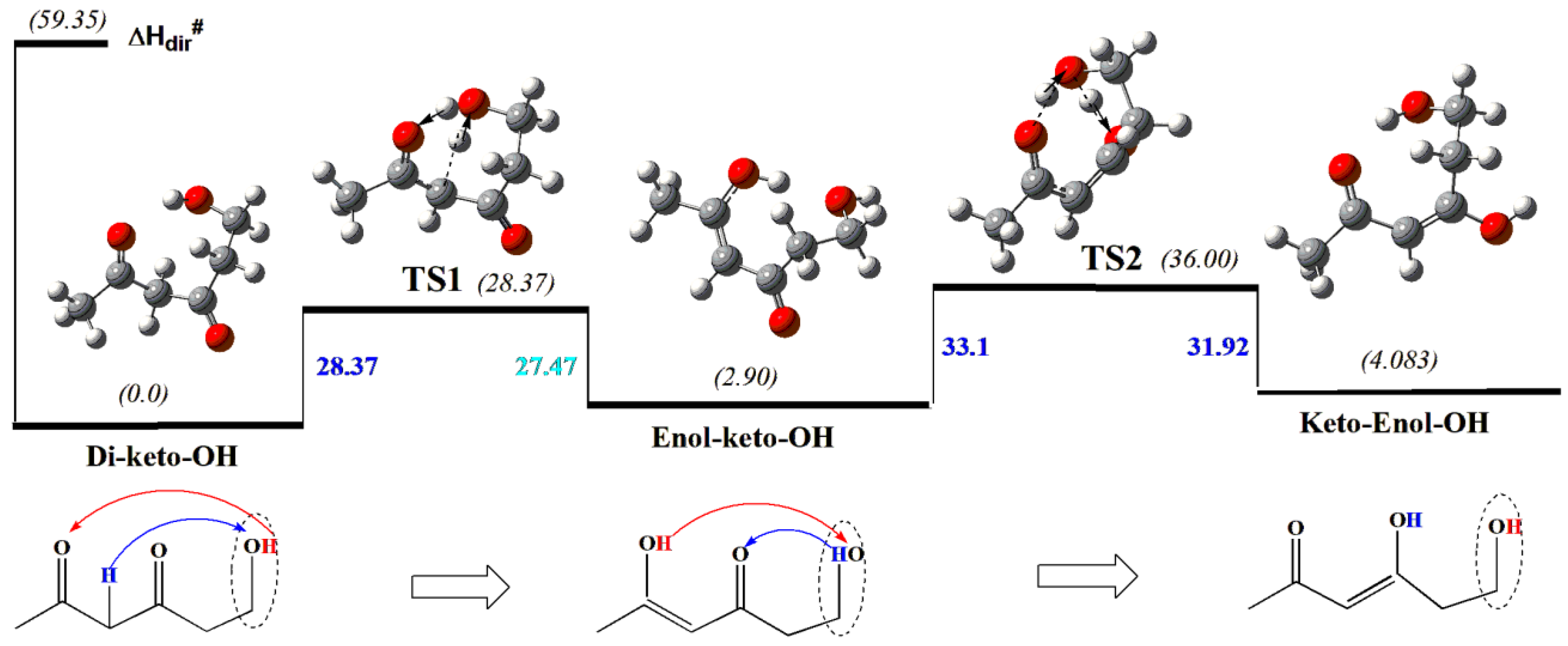
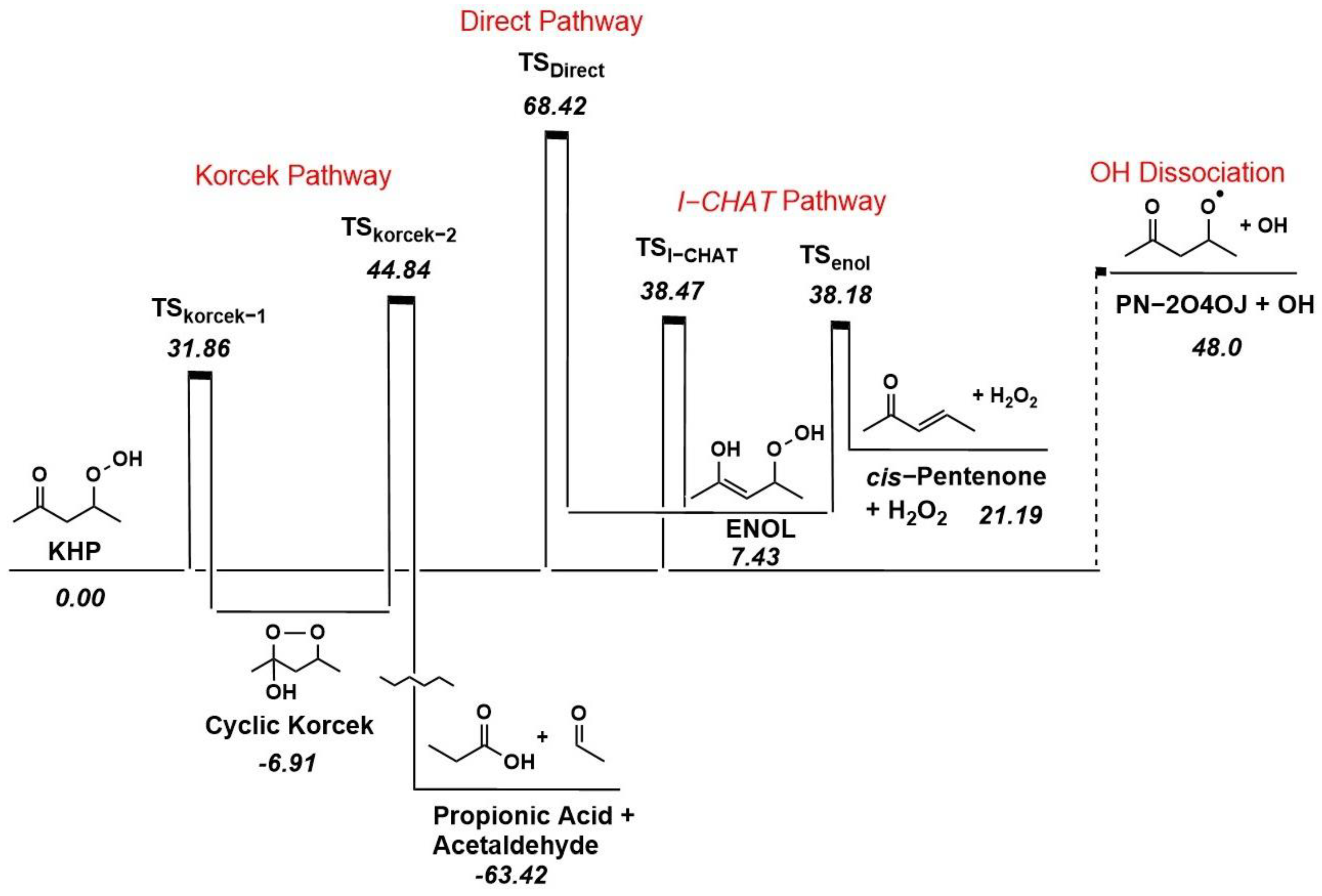

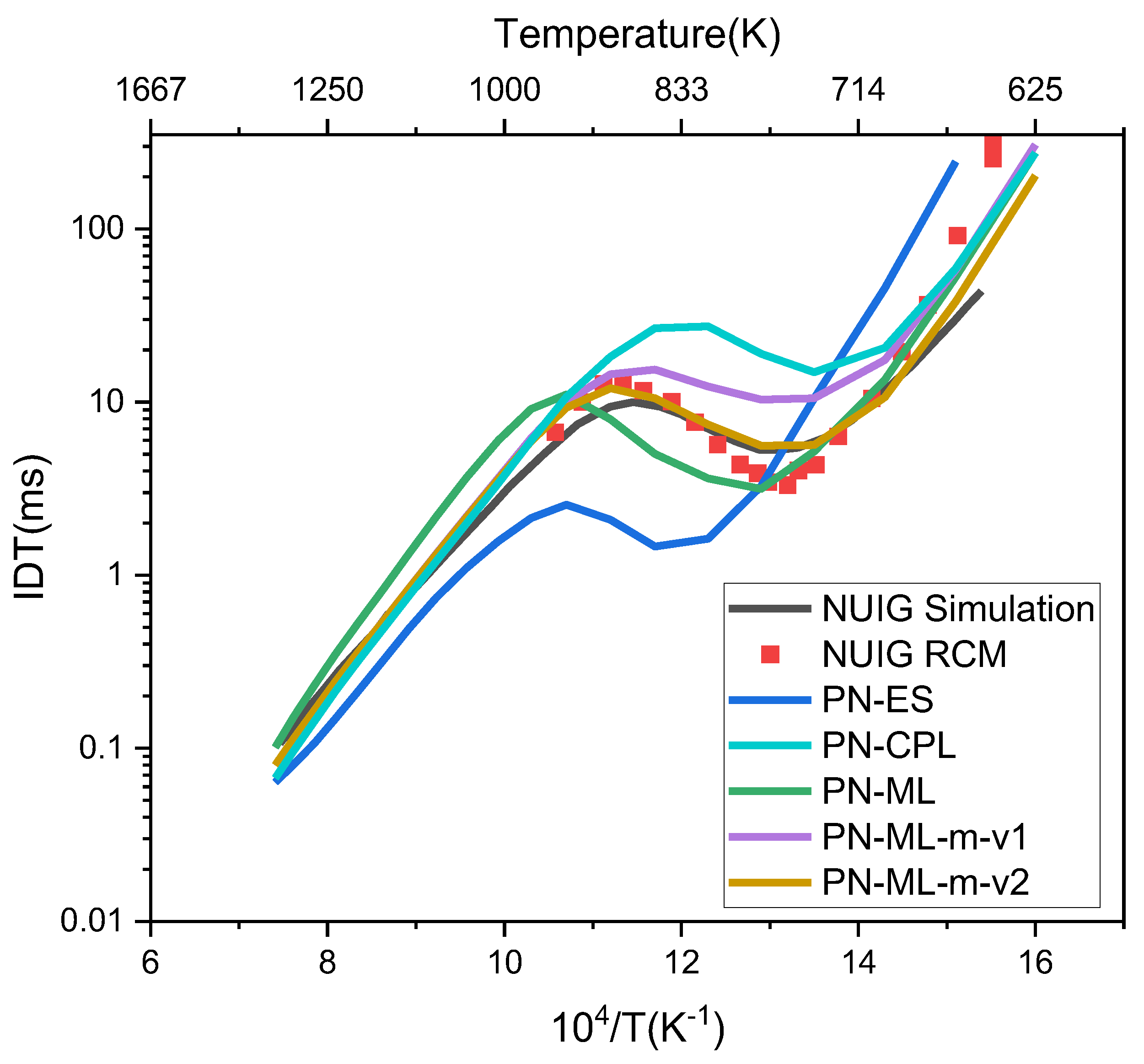
| Reaction Pathway | A (s−1) | n | E (kcal/mol) |
|---|---|---|---|
| KHP → Cyclic Korcek | 8.46 × 10−3 | 3.70 | 24.99 |
| Cyclic Korcek → Propionic Acid + Acetaldehyde | 1.89 × 10−10 | 1.17 | 51.50 |
| KHP → ENOL (I-CHAT) | 2.37 × 10−5 | 4.57 | 30.06 |
| KHP → ENOL (Direct) | 8.86 × 10−42 | 15.74 | 40.02 |
| ENOL → cis-Pentenone + H2O2 | 5.53 × 108 | 1.20 | 29.64 |
| KHP → PN-2O4OJ + OH | 4.33 × 1019 | 0.80 | 47.80 |
| Reactions | A (s−1) | n | E (kJ/mol) |
|---|---|---|---|
| KETO_24 = ENOL_24 | 2.37 × 10−5 | 4.57 | 125.8 |
| KETO_13 = ENOL_13 | 416 | 2.53 | 137.8 |
| KETO_25 = ENOL_25 | 8.42 × 1012 | 6.53 | 111.2 |
| ENOL_13 = 2-Pentenal + H2O2 | 1.194 × 1011 | 0.482 | 115.9 |
| ENOL_24 = H2O2 + cis-Pentenone | 5.531 × 108 | 1.199 | 124.0 |
Disclaimer/Publisher’s Note: The statements, opinions and data contained in all publications are solely those of the individual author(s) and contributor(s) and not of MDPI and/or the editor(s). MDPI and/or the editor(s) disclaim responsibility for any injury to people or property resulting from any ideas, methods, instructions or products referred to in the content. |
© 2025 by the authors. Licensee MDPI, Basel, Switzerland. This article is an open access article distributed under the terms and conditions of the Creative Commons Attribution (CC BY) license (https://creativecommons.org/licenses/by/4.0/).
Share and Cite
Asatryan, R.; Hudzik, J.; Amiri, V.; Swihart, M.T. Internally Catalyzed Hydrogen Atom Transfer (I-CHAT)—A New Class of Reactions in Combustion Chemistry. Molecules 2025, 30, 524. https://doi.org/10.3390/molecules30030524
Asatryan R, Hudzik J, Amiri V, Swihart MT. Internally Catalyzed Hydrogen Atom Transfer (I-CHAT)—A New Class of Reactions in Combustion Chemistry. Molecules. 2025; 30(3):524. https://doi.org/10.3390/molecules30030524
Chicago/Turabian StyleAsatryan, Rubik, Jason Hudzik, Venus Amiri, and Mark T. Swihart. 2025. "Internally Catalyzed Hydrogen Atom Transfer (I-CHAT)—A New Class of Reactions in Combustion Chemistry" Molecules 30, no. 3: 524. https://doi.org/10.3390/molecules30030524
APA StyleAsatryan, R., Hudzik, J., Amiri, V., & Swihart, M. T. (2025). Internally Catalyzed Hydrogen Atom Transfer (I-CHAT)—A New Class of Reactions in Combustion Chemistry. Molecules, 30(3), 524. https://doi.org/10.3390/molecules30030524








